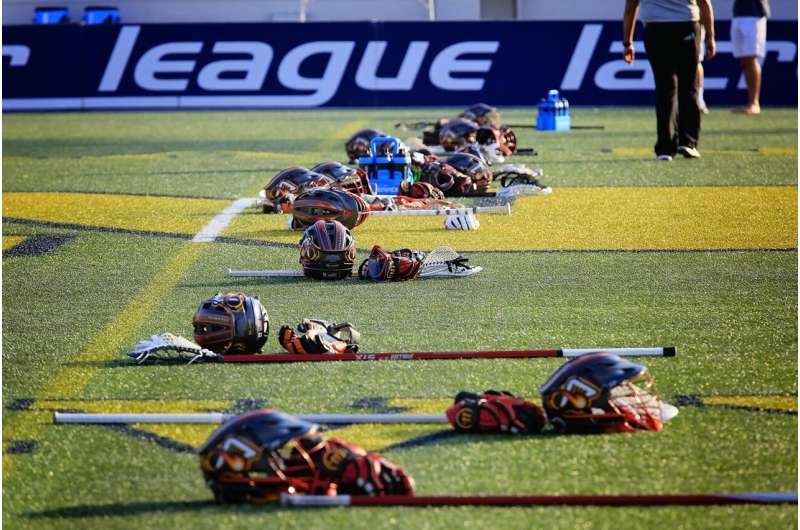Study: Headgear significantly reduces girls’ lacrosse concussions

Female high school lacrosse players are significantly less likely to sustain concussions and other injuries if they wear headgear, a landmark study led by University of Florida Health researchers has found.
Girls who play the sport in states that don’t require headgear had a 59 percent higher concussion rate than players in Florida, the only state with a headgear mandate. The researchers also found lacrosse games were more hazardous than practices: Concussions were 74 percent higher during competition among players in states without headgear requirements when compared with Florida players.
Those details emerged from data collected during 357,225 games and practices in Florida and other states during three seasons from 2018 to 2021. The findings were presented today at the American Academy of Pediatrics national conference.
Within the sport and its governing bodies, the use of headgear among female high school lacrosse players has been debated thoroughly and passionately, said Daniel C. Herman, Ph.D., M.D., who led the research as an assistant professor in the UF College of Medicine’s department of orthopedic surgery and sports medicine. He expects the findings will provide solid, objective guidance to school boards and state athletic associations across the country as well as the sport’s national governing body.
“This will allow people in many different organizations to make evidence-based athlete safety policy choices,” Herman said.
While boys’ lacrosse is a contact sport and requires full headgear, stick-to-stick is the only contact allowed among girls’ teams. Despite the lack of a definitive scientific consensus on the headgear’s ability to reduce concussion risks, the Florida High School Athletic Association required standardized protective headgear for girls’ lacrosse beginning in 2018. In other states, mouthguards and eyewear are the only mandated protective equipment.
In a game where a hard ball can reach 50 mph or more, headgear seems sensible to some involved with the sport. However, others note headgear potentially makes the game more dangerous—a factor known as risk compensation or the Peltzman Effect. It holds that players who have more protection act with less caution. In lacrosse, the concern is players might be more aggressive with opponents who use headgear. However, they stressed that additional research on this question is needed.
To address that, Herman and his colleagues compared player versus equipment concussions with those caused by contact with the ground or other players. If risk compensation was happening among headgear-wearing players, the researchers said it would be reasonable to expect concussions caused by equipment to drop while the concussion rates for other types of contact would increase. That didn’t happen among the study participants, leading the researchers to conclude that headgear use might not encourage more aggressive play.
To establish their findings, the researchers analyzed the equivalent of 76 full seasons of data from Florida high schools and 166 seasons of data from other states in 2019 and 2021. Partial-season data from the coronavirus-shortened 2020 season also was included. Data was collected by school athletic trainers and compiled through a national high school injury registry.
There were 141 documented concussions in three seasons, including 116 in 266,141 practices/games among players without headgear and 25 in 91,074 practices/games who wore protection. Most concussions (53 percent) were caused by contact with a stick or ball. Player and ground contact accounted for 27 percent and 18 percent of concussions, respectively.
Significantly more concussions occurred in games than practices, which Herman attributes to several factors: players’ familiarity with teammates and their tendencies, the typical speed of play during games and the intensity of game competition. Headgear use was not associated with any significant differences in concussions during practice.
“There are a lot more variables that take place during games and a lot more at stake for players,” Herman said.
Lynn Millinoff, co-head coach of the girls’ lacrosse team at Buchholz High School in Gainesville, said she was not surprised by the findings. Still, in her experience, mandatory helmets have changed the way the game is played and officiated. Players feel less vulnerable and officials are now less likely to call penalties for stick blows to the head, Millinoff said.
Headgear alone is also no magic bullet for safety, she said. Because current headgear is not adjustable, some players modify it by cutting away at part of the interior—potentially negating some of its protection. The headgear’s inflexibility can also be an issue when players hit the ground, she added. One of Millinoff’s players suffered concussions in consecutive seasons when her helmet hit the turf. Because the helmet was inflexible, the player’s head didn’t move when she hit the ground—which Millinoff likened to landing on concrete.
Millinoff, who has traditionally opposed a headgear mandate for a variety of reasons, said the researchers’ findings could lead her to be more supportive of that rule.
“Logically, it means that—as many times as we have seen players get hit in the head—helmets would help,” she said.
However, it’s also crucial to consistently enforce head-blow rules that Millinoff says game officials have relaxed since headgear was required. Manufacturers also need to make their headgear adjustable and more comfortable, she added.
Millinoff said the concussion results could also prompt state athletic officials to extend the headgear requirement to include practices and the fall and summer mini-seasons, which are currently exempt from the rule.
The findings might also lead to further studies, which Herman said could include the potential influence of headgear on non-concussion injuries and headgear’s impact on injuries among younger players.
In addition to Herman, who joined the University of California, Davis earlier this month, the research team included Heather K. Vincent, Ph.D., research director of UF’s department of physical medicine and rehabilitation, and researchers from the University of New Hampshire, George Mason University and MedStar Health Research Institute. The study was funded by U.S. Lacrosse, which is the sport’s national governing body, and the National Operating Committee on Standards for Athletic Equipment.
Source: Read Full Article



